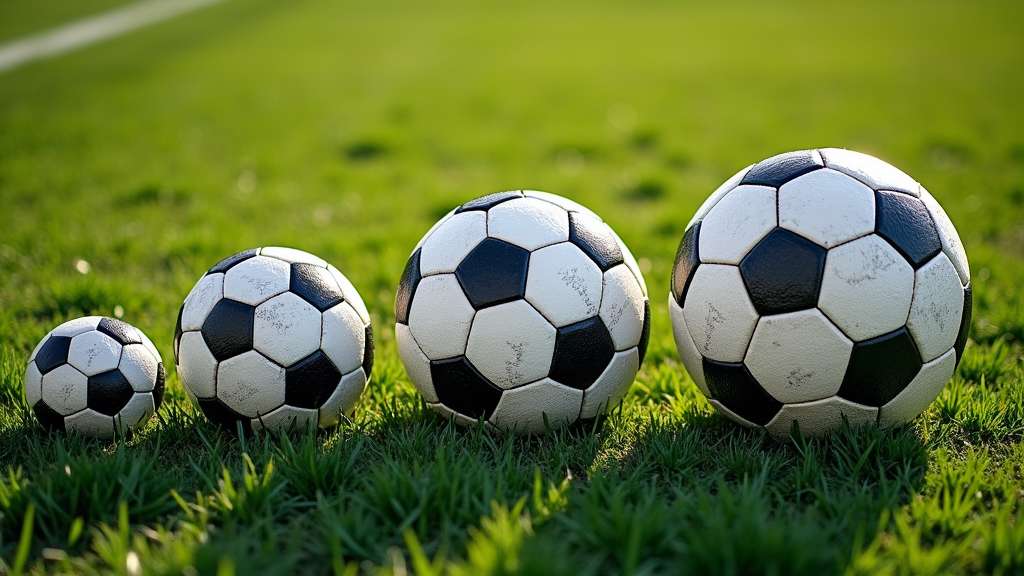Finding the right soccer ball size for your kid or for yourself can make playing the game more fun and even help with learning proper skills. Soccer balls come in several sizes, and picking the correct one for each age group is actually pretty important for comfort, development, and safety. Here’s an all-in-one guide to soccer ball sizes by age, why it matters, and what you’ll want to know before grabbing a ball your next game or practice session. www.wealthyaffiliate.com?a_aid=a12e49d9

Understanding Soccer Ball Sizes
Soccer balls are numbered so that it’s always possible to grab the right fit based on the player’s age and needs. Every size has a specific diameter, weight, and recommended age group. Using a ball that’s too big or too small can impact passing, shooting, and control, especially while players are still learning.
The main soccer ball sizes you’ll run into are Size 1, Size 3, Size 4, and Size 5. Size 2 does exist, but it is pretty rare and usually used for promotional purposes rather than actual play.
Soccer Ball Size Guide by Age
The simplest way to match a player to a ball is by checking the age and using the chart most leagues, coaches, and manufacturers recommend. Here’s a quick breakdown:
- Size 1 (Miniball): Under 3 years old or for skill drills, juggling, and fun
- Size 3: 3 – 7 years old
- Size 4: 8 – 12 years old
- Size 5: 13+ years old (teens and adults, including all professional play)
These recommendations cover most recreational, developmental, and league play situations. Some leagues may have slight variations, but this list is what I’ve always seen used for both coaching and play.
Key Features of Each Ball Size
Each soccer ball size feels a bit different when handling, kicking, or passing. Here’s what I’ve found from coaching and playing with every size:
- Size 1 (Miniball): Measures 18″ – 20″ around, weighs 7 oz or less. This one is mainly for skill training, juggling, and young kids just exploring the sport. It’s also pretty handy for practicing ball control at home, even for adults.
- Size 3: Measures about 23″ – 24″ around, 11 – 12 oz. This is the starter ball for preschool and young elementary players. It’s lightweight, easy to control, and gentle for small feet and legs, making it a great way to help kids build basics like dribbling and passing.
- Size 4: Measures 25″ – 26″ around, just about 12 – 13 oz. This one is perfect for players making the jump from the smaller kids’ leagues to more formal play but who aren’t quite ready for adult sized gear. It helps preteens develop proper technique without straining muscles or joints.
- Size 5: Official size: 27″ – 28″ around, weighs 14 – 16 oz. This is the standard for all players aged 13 and up, so it’s what you’ll see in all high school, collegiate, and pro play. It’s heavy but sturdy, built for power and long passes.
Why Ball Size Matters for Skill and Safety
Having the right size isn’t just about being comfortable; it’s also about helping players learn and stay safe. Small kids struggle to get power and control with a ball that’s too big or too heavy. Besides getting frustrated, there’s also a risk of straining muscles, picking up bad habits, or even dealing with preventable injuries, like jammed toes or awkward kicks.
On the other hand, using an age-appropriate ball helps kids form proper technique, build confidence, and enjoy the game more. Most coaches I know wouldn’t let a sixyearold play with a Size 5 ball. It just doesn’t help them progress.
Tips for Choosing the Best Soccer Ball by Age Group
Choosing the right soccer ball for different age groups goes beyond just picking the size off the shelf. There are a few practical things to keep in mind to get your money’s worth and make sure players get all the benefits they should.
- Always Check League Rules: Some youth leagues have their own guidelines or occasionally use intermediate sizes, so double checking with your coach or team manager avoids confusion.
- Let Kids Hold the Ball: If you’re shopping in store, let the player hold, dribble, and kick before making a decision. It helps gauge what feels comfortable for them.
- Consider Durability: Younger players and new players tend to be rougher on their equipment. Go for a ball with tough outer material, especially for outdoor use to make sure the ball holds up.
- Inflation & Maintenance: Make sure you keep the ball properly inflated. An underinflated ball is tough to kick and won’t bounce right, while an overinflated ball can feel like kicking a rock.
Common Challenges When Picking Soccer Balls
Even with easy-to-follow age charts, there are a few common hiccups and things people overlook when choosing a soccer ball, especially for beginners and young families:
- Not Realizing Practice Balls Exist: Some balls are made just for practice and skill drills, not for actual match play. These usually have a different feel and can help with coordination or quick touches, but aren’t for team practice or competition.
- Outdoor vs Indoor Play: If you plan to play mostly on gym floors or turf, go for indoorfriendly balls. They often have felt covers or builtin features that deal better with those surfaces.
- Too Many Fancy Features: Don’t get distracted by eyecatching designs or unnecessary tech, like Bluetooth trackers or odd shapes, especially for kids under 10. Keeping it simple is usually best for skillbuilding.
- Ignoring Ball Weight: Sometimes, the official size might be right but the weight is off. Double check that the ball isn’t too heavy for the player’s age and build.
Soccer Ball Maintenance: Tips That Save Time
I’ve found that looking after your soccer ball means it’ll last longer and play better, which is super important if you play several times a week. Here are some ways to give your ball a boost in longevity:
- Store the ball in a dry, cool place; not in direct sunlight or in the trunk of your car, which can mess with the cover and stitching over time.
- Wipe off mud and debris after use, especially if playing on grass or dirt, so the ball lasts longer and stays looking good.
- Check and adjust the air pressure regularly. Most balls list a range on the valve, usually between 8.5 and 15.6 PSI, depending on size.
- Fix small punctures with a ball repair kit. Most are affordable and easy to keep in your soccer bag if you play a lot.
Frequently Asked Questions
Here are a few questions that come up pretty often when it comes to soccer ball sizes:
Question: Why should young kids use smaller balls?
Answer: Smaller balls help little players develop skills faster and with less risk of injury. They’re easier to dribble, pass, and shoot, making the game more fun for everyone.
Question: Can my child use a bigger ball to “advance” skills?
Answer: Using a larger ball before a kid is physically ready can actually slow progress and cause frustration. It’s best to stick to the recommended sizes until toes, feet, and muscles are strong enough to handle the next step up.
Question: What difference does a match ball vs training ball make?
Answer: Match balls are usually higher quality, tested to meet league specs, and balanced for predictable play. Training balls are built tough to handle more abuse, though they might not feel quite as snappy as the pro models. It’s totally okay to use a training ball for most practices.
RealWorld Examples: How Ball Size Impacts Games and Practice
I’ve seen firsthand how the right ball size boosts skill and excitement, especially in youth leagues. Kids using the right size tend to get more involved and aren’t shy about trying new moves. Once, a 9yearold on my team was struggling to learn how to juggle the ball. We swapped a size 5 out for a size 4, and suddenly the drills made way more sense, her touches improved, and her confidence jumped.
Even at older ages, the right sized ball can help prevent issues with injury. Teens making the transition to adults’ league sometimes need a few weeks to adjust to the size 5 ball. That’s totally normal; actually, building up gradually is something a lot of coaches recommend to help avoid injuries and let muscles adapt.
Parents have sometimes shared that choosing the right ball also keeps their kids more excited to practice at home. If the ball fits the player well, they’re more likely to pick it up and try new moves or play with friends, which builds more lasting skills overall. Small upgrades like choosing the ideal ball size can really give motivation a boost for all ages.
Final Thoughts
Picking the right soccer ball is a simple step that makes a huge difference in how fun and safe it is to play, especially for kids and players still mastering the basics. Matching ball size to age means players develop their skills in the quickest way possible, avoid unnecessary frustration, and get even more enjoyment out of the beautiful game. Whether you’re shopping for a little kid’s first ball or gearing up for teens and adults, a properly sized ball can keep everyone playing their best and having a good time.
